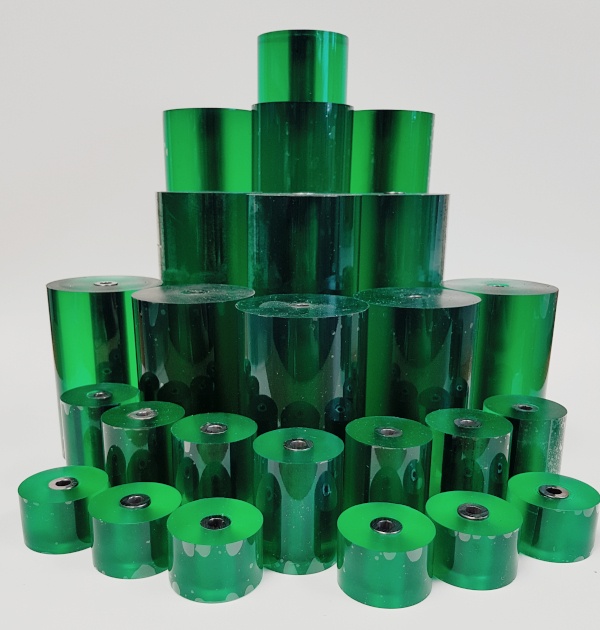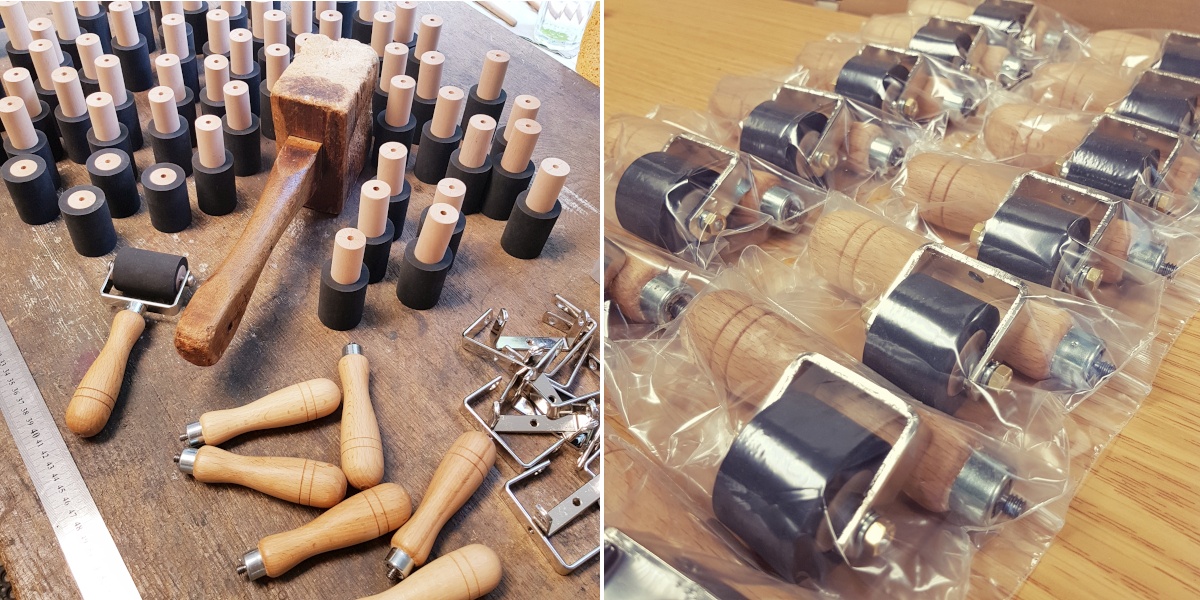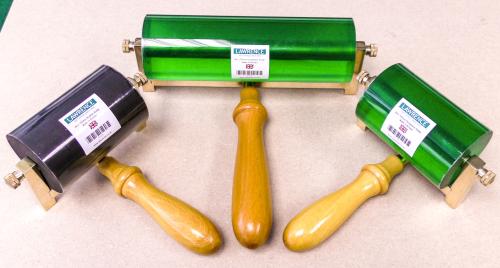The Lawrence Guide to Choosing your Rollers
Lawrence rollers are famous for their attractive design, high quality and durability and they have enjoyed a huge popularity among generations of printmakers. Each roller is carefully and lovingly assembled in our Hove warehouse by our experienced production team. Whether you are looking for your first roller, replacing a much-loved oldie or perhaps it is time to expand your collection, this guide will help you make a well-informed decision to get a roller that will be your trusted pal for years or even decades to come.

1. Materials

Durathene rolls in an 'Emerald City' formation
We make two types of rollers: rubber or durathene. Most printmakers will have commonly used rubber rollers during their career, and it is considered the more common type. Durathene is a special type of polyurethane that is, as its name suggests, a very durable material, less prone to degradation. It is a transparent emerald colour and it is odour-free unlike rubber. Both materials are available in student and artist quality (more on this later) to suit every budget. It is important to note that if you plan to use solvents for cleaning your rollers, you should choose rubber. We suggest you clean your durathene rolls with soapy water or oil, and both types of rollers should be dried and kept away from heat. If you want to know more about keeping your rollers in a good condition, read ‘Frequently Asked Questions: Caring for your Rollers’ where we discuss the effects of humidity, heat and dust and the best cleaning methods for both rubber and durathene.
2. Hardness (shore value)
When it comes to choosing between rubber and durathene, artist and student quality, the hardness of the roll, defined in shore values, is a crucial element to consider. The higher the shore value, the firmer the roller. Our durathene rolls have the lowest shore value (25-30), both in our student and artist range. This makes them perfect for relief printmaking where the soft material can easily reach the smallest details. And the softer the roller, the less pressure you need to apply which is very helpful for those hands already tired from the relentless carving!

Soft rollers: Artist and Student Quality Durathene and Artist Quality Rubber
Our rubber, on the other hand, comes in two different hardness. Our artist quality rolls come with a soft rubber (30 shore), and they are only slightly firmer than durathene, which makes their applications much the same. If you are looking for a hard rubber roller, our student range is your best option as each roller comes with a rubber that has a shore value of 65-70. Hard rollers are particularly useful for inking etching plates, where the stiff ink needs the pressure to go deep into the impressions of the metal plates. Hardness is also desired for techniques such as lithography, woodblock inking (it helps the wood pattern come through), viscosity printing (which alternates high and low viscosity inks and soft and hard rollers) and also for the application of grounds in etching.

Making Student Quality Robber Rollers and the finished batch
3. Measurements
There are two sides to this coin: thickness (diameter) and length. The thicker the roller, the more ink it will take up and the less rolling and re-inking you will have to do. Our artist quality rollers come in 5cm (2”) and 6,4cm (2,5”) thickness. Our student quality rollers are 3,8cm (1,5”) thick. Student rollers are perfect for smaller projects where you don’t have to cover a big area all in one go, when working with multiple colours or when doing detail work as their smaller size makes these easier to reach. The length works in a similar way: short ones are for small areas, long ones for big ones. When covering a block with a single colour, it is advisable to use a roller length slightly larger than the block, as it will help achieve a uniform coverage. And finally, use the thickest, longest rollers for those very large projects. Our artist quality range goes up to 45cm length, which is so large it has two handles!

Our entire range of Artist Quality Durathene Rollers in 6,4cm diameter
Tip: we are often asked about what size we suggest for (relief) printmakers who are just starting out. Since most beginners work on smaller projects, it is a good idea to get a detail roller (2,5cm or 5cm long student quality, either rubber or durathene) and one that can cover most or all of your regular plate size (10cm or 15cm long). As you start doing larger projects, the sizes of the rollers will increase too, but these roller sizes will always be helpful on the long run.
4. Differences between Student & Artist Quality Rollers
As mentioned above, student quality rollers are smaller in diameter (better for small projects and detailing) and the rubber used is harder than that of the artist rollers (more suitable for etching, etc.). Additionally, student rollers are lighter, so even the largest size (17.8cm or 7”) is easy to handle. The student range is just as great as the artist one: these rollers are made with wooden and metal components rather than cheap plastic and they have an economical price tag.

Student Quality Rollers: Small and Big, Durathene & Rubber
The artist quality rollers have a lot of advantages too. They are made of more durable materials and they will last you a long time when handled with care. Artist rollers are made with beautiful brass frames and beech wood handles which makes them attractive and more comfortable to hold despite their heavier weight. They have larger thicker rolls with a choice between 5cm and 6,4cm diameter, offering a bigger surface and saving you time when inking your plates. And while the student range end at 17,8cm length, the artist rollers are available with up to 45cm length.

A batch of Artist Quality Rollers fresh off our production line
Buying a roller is a decision that will affect your work on the long term, so we advise you to invest in quality equipment. We don’t use cheap plastic frames and handles in making our rollers as they degrade quicker and are more prone to breaking. Our rollers are designed to be your reliable companion for years and decades to come and we offer replacement rolls for our entire student and artist range for when the rolls wear out. The wooden and metal parts are durable and recyclable, and it’s all assembled locally, which makes Lawrence rollers a great choice for the environment too!
We hope you enjoyed this guide and don't forget, we are happy to answer any of your questions about printmaking rollers!







